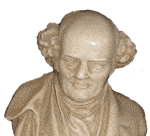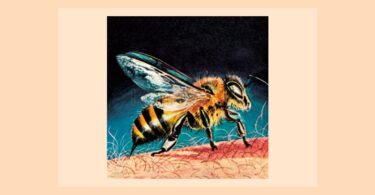Hahnemann’s discovery of the nature of chronic disease is one of the greatest discoveries in the history of medicine. Over 200 years ago, Hahnemann presented a holistic perspective to disease which predated many of the concepts and attitudes that we now consider part of an alternative medicine practice. To fully understand how Hahnemann came to this, let’s put this discovery into a context by briefly considering the major steps in Hahnemann’s development of homeopathy.
The Major Discoveries of Hahnemann
How Medicines Actually Cure Disease
In 1790, Hahnemann for the first time experimented with the effects of a single medicine on his own body. Prior to this, medicines were prescribed in complex formulas with dozens or hundreds of substances mixed together.
The action of these prescriptions of the time was unknown. The presumed effect, based on theories of centuries before, was passed from generation to generation on the basis of authority. It was rare for anyone to question this reliance on authority and individual experimentation was undreamed of.
Hahnemann, through his study of drugs and chemicals, came to the conclusion that it was necessary to understand the action of each ingredient of a prescription to be able to prescribe accurately. While translating a medical text popular at the time, he found himself questioning the explanation of the effect of China or “Peruvian bark”. Kina (China) is the Peruvian word for “bark” and it was introduced into Europe for the treatment of fevers. It is the source of the alkaloid, quinine. The text that Hahnemann was translating said that the therapeutic effect of China was through its bitter and astringent quality. Hahnemann questioned this saying “By combining the strongest bitters and the strongest astringents, one can obtain a compound which, in small doses, possesses much more of both these properties than the bark” yet he found that this was not effective in treating fever (as was China). So the question became “How does it actually work?”
Hahnemann’s unique contribution and his first major discovery was to try this herb on himself. He describes it like this: “I took by way of experiment, twice a day, four drachms1 of good China. My feet, finger ends, etc. at first became cold. I grew languid and drowsy; then my heart began to palpitate, and my pulse grew hard and small; intolerable anxiety, trembling (but without cold rigor), prostration throughout all my limbs; then pulsation in my head, redness of my cheeks, thirst, and, in short, all these symptoms, which are ordinarily characteristic of intermittent fever, made their appearance, one after the other, yet without the peculiar chilly, shivering rigor.”
“This paroxysm lasted two or three hours each time, and recurred if I repeated the dose, not otherwise. I discontinued it, and was in good health”.
This experiment had carried him further than anticipated. It had taught him that those effects were apparently the same as the symptoms of the disease it was given (with undeniable success) to cure. He then asked, “Does this bark produce the same symptoms as it removes? This medicine is called a specific. Is the specific curing power of drugs founded on such a principle? Do they all produce an artificial disease similar to the natural disease for which they are beneficial?”
These questions led to experimentation with the major medicines of the time—medicines that we now know as commonly used homeopathic remedies, like Aconitum, Belladonna, Arsenicum, etc. Six years were expended in testing medicines and verifying this principle before proclaiming it to the world. Eventually the findings were published in the “Materia Medica Pura”, the pure action of single medicines—the first time in medical history that the specific action of medicines was described.
Necessity for the Smallest Dose.
As Hahnemann tested medicines, understood their action, he began to use them in treatment of the sick. Unexpectedly, he found that when the medicines were used one at a time (and based on their similarity to the natural disease) that the patient was unusually sensitive to their influence. Indeed, the dose had to be considerably reduced from the teaspoons or tablespoons usually given or the effect was too strong.
It was in 1799 that Hahnemann introduced the idea of using an unusually small dose in treatment. This came primarily with his experience of using Belladonna in the treatment of scarlet fever in children, in which he found it necessary to reduce the dose to one drop, to a fraction of a drop, and finally a drop of greatly diluted medicine.
So, this was Hahnemann’s second great discovery—that when medicines were used because they were similar to the patient’s suffering, that the patient was correspondingly excessively sensitive to their influence and the medicine therefore had to be given in a very small dose.
Recognition of Potency.
The third important discovery was of potency. Gradually, through the use of diluted medicines in small doses, Hahnemann observed that the process of dilution and shaking strongly to mix the medicines seemed to make them more effective as to their curative effects and less harmful as to their physiological action. This was a gradual discovery and apparently not one that he considered a priori.
In the sixth edition of the Organon, he describes it like this: Homeopathic preparation of medicine “develops to a formerly unheard of degree the internal, spirit-like medicinal powers of crude substances…….whereby these substances become altogether more than ever—indeed, immeasurably—penetratingly effective and helpful, even those substances which, in their crude state do not manifest the least medicinal power in the human body.”2
“This procedure develops the latent dynamic powers of the substance, which were previously unnoticeable, as if slumbering. The dynamic powers of these substances mainly have an influence on the life principle, on the condition of animal life. Therefore, this process is called dynamization or potentization (development of medicinal power).”3
Understanding the Nature of Chronic Disease.

Before we discuss this further, let’s look at how Hahnemann came to see the need for this discovery.
Hahnemann’s homeopathic method had been tested in the field for years with wonderful success, especially in the treatment of serious acute diseases. However, it was gradually noticed by Hahnemann that a group of patients with slower, persistent disease problems were helped only partially. It was not that the patients were particularly complaining, but Hahnemann was not satisfied. He put it like this:
“A patient thus treated might and often did consider himself in pretty good health, when he fairly judged of his present improved state and compared it with his far more painful condition before Homeopathy had afforded him its help.”5 But he was not cured.
Unfortunately, with time, the patient gradually became worse instead of retaining what progress had been made. New symptoms would appear that added to the original ones and increased the burden of disease. The patient would also easily relapse from such seemingly slight causes as emotional upset, an injury, or from becoming ill from an acute disease—like a “cold” for example. As homeopathic treatment was continued the medicines gradually lost their effectiveness and the patient could not be helped.
“The chronic disease could, despite all efforts, be but little delayed in its progress by the homeopathic physician and grew worse from year to year.”6
Hahnemann’s conclusion as to the result of treatment of this class of diseases was “Their beginning was promising, the continuation less favorable, the outcome hopeless.”7 Nonetheless, Hahnemann still thought that what he had discovered and used with success in acute conditions should be able successfully treat this problem as well. But why did these patients not respond permanently as did most others? The investigation of this problem occupied Hahnemann for 14 years, from 1816 to 1828. His findings boil down to a few essentials:
There is one major chronic disease responsible for almost 90% of chronic illness seen in human beings. This he called Psora.
There are two minor chronic diseases associated with venereal infections—gonorrhea and syphilis—called Sycosis and Syphilis respectively.
It is characteristic of these chronic diseases that the patient cannot recover on her own and the battle between disease and person goes on continuously throughout the lifetime of the individual.
Most of the chronic disease is kept in a “latent” form during the early years. This is done as a strategy that the body has for dealing with this incurable condition. A localized lesion is produced that becomes the expression of the internal chronic disease. As long as this exists, the internal disease does not develop very quickly at all.
If this localized lesion is destroyed by treatment (e.g., surgery, use of ointments or caustics, by inappropriate use of medicines—allopathic or homeopathic) then the internal chronic disease becomes more active and the patient becomes progressively more ill.
It is the disease’s purpose to destroy the body; it is the body’s defense to localize the disease at one location and, if possible, periodically produce discharges to allay the influence of the disease.
Suppressive allopathic treatment over the centuries, based on a misunderstanding of this dynamic, has caused the primary miasm, Psora, to evolve into hundreds of forms of more serious illness—though they all remain the same disease in essence.
What is Psora?
Psora is by far the most important chronic disease that affects human beings and animals. Most of Hahnemann’s writings in The Chronic Diseases are about this condition. Through careful study of patients, how their chronic disease first began (e.g., the first symptoms) and also a detailed survey of the history of diseases Hahnemann was able to say that Psora starts as an itching eruption of the skin.
Hahnemann describes Psora as “that most ancient, most universal, most destructive, and yet most apprehended chronic miasmatic disease which for many thousands of years has disfigured and tortured mankind and which during the last centuries has become the mother of all the thousands of incredibly various chronic diseases, by which the whole civilized human race of the inhabited globe is being more and more afflicted.”8
What an amazing and unexpected finding—that the most significant and common chronic disease has the form of an itching eruption!
Hahnemann was able to trace the evolution of this condition from the earliest times (its origin is before our written records) and show that it was the same disease that has also been called leprosy in the bible. In contrast to what we think now of as leprosy with the rotting nose or dying fingers, the leprosy of the time of the bible is described as “similar to an inveterate itch with violent itching”. It was terrible in appearance because of the sores and scabs and discoloration of the skin—much like we see in dogs with skin disease.
Psora also later manifested as what was called “St. Anthony’s Fire”, a form of erysipelas or superficial cellulitis of the skin. This was a severe disease from which many suffered and died during the Middle Ages.
With time and continued external treatment of Psora, it is Hahnemann’s opinion that Psora evolved into a more internal disease with milder external manifestation—basically the external aspect appearing as an itchiness of the skin with or without a few vesicles or pimples showing up. As the skin manifestation (during the evolution of Psora) became less, the internal development increased—no longer able to localize on the surface of the body at all. Depending on the particular constitution of the individual, the disease will take the form of so many of the frustrating clinical conditions that we frequently see in daily practice. Examples of this are:
- Inflammatory bowel disease.
- Hypo- and hyperthyroidism.
- Chronic sinusitis.
- Chronic hepatitis.
- Fatty liver syndrome.
- Peri-anal fistula.
- Hip dysplasia.
Psora as an Infectious Disease.
Through his work with patients, Hahnemann was able to determine how Psora spread from one person to another—or to an animal—or from an animal to a human being.
When Psora has an external manifestation (e.g., skin lesions) it is highly contagious. It takes only a single touch or contact with clothing or bandages from the patient to contract the disease. Upon touch it is immediately transmitted via the nervous system throughout the entire body. For most individuals, there is a period of 6-14 days during which Psora is coming to full development. The whole organism feels that it is being changed by the presence of the disease and tries to eliminate it through the skin. At the end of this developmental period, there is the manifestation:
A slight chill in the evening and a general feeling of heat or fever.
The second night there is some perspiring during the night.
Following is the skin eruption of small vesicles usually first in the region where Psora was first contacted.
This eruption is accompanied by “a voluptuously tickling itching….which compels the patient so irresistibly to rub and to scratch the vesicles of itch, that, if a person restrains himself forcibly from rubbing or scratching, a shudder passes over the skin of the whole body. This rubbing and scratching, indeed, satisfies somewhat for a few moments, but there then follows immediately a long-continued burning of the part affected. Late in the evening and before midnight this itching is most frequent and most unbearable.”9
It is the External Form Psora that is Infectious.
The itching not only compels the patient to rub, but on account of its violence, as mentioned before, to rub and scratch open the vesicles; and the fluid pressed out provides abundant material for infecting the surroundings of the patient and also other persons not yet infected.
Only this skin symptom of the Psora which has permeated the whole organism, only this eruption, as well as the sores which later arise from it are attended on their borders with the itching peculiar to Psora, as also the herpes which has this peculiar itching and which becomes humid when rubbed, as also the tinea capitis—these alone can propagate this disease to other persons, because they alone contain the communicable miasma of Psora.
The remaining secondary symptoms of Psora, which in time manifest themselves after the disappearance or the artificial expulsion of the eruption, cannot at all communicate this disease to others.10
Significance of Hahnemann’s Discovery for Practice.
These discoveries of Hahnemann as to the nature of chronic disease give us a tremendous tool for understanding the condition our patients are in. Whereas before we would see diseases as occurring independently and unrelated to one another, now we can understand that there is one primary disease that is the same nature from the beginning until the end.
In practice, we can elicit information as to the different symptoms an animal has shown from infancy to the present time. These are all the same disease, Psora, that is developing and evolving over the years. From this we can develop a treatment that is inclusive of all the ways this disease has manifested in this individual animal.
Another way to put this is that if we take a reference book on Dermatology, for example, this entire book in all its detail, is discussing the many manifestations of Psora. Treatment of the individual manifestations misses the mark. It is the whole animal that is sick and treatment must be directed to this whole patient to be successful.
Further, if the external form of chronic disease—the skin itch—is simply suppressed by treatment, then the same disease develops more internally. The many other conditions given diagnostic names (now we look at a book on Internal Medicine) are actually one disease.
The reverse phenomenon also has significance. If during treatment, an internal problem improves and a skin eruption returns to the skin, then the case is progressing in a favorable direction. This helps us to understand that going through a phase of skin itch will be a common occurrence because this is the essential nature of the chronic disease, Psora, from the beginning.
This explanation of Psora as the primary chronic disease that we see in animals helps us to understand how so many of our dog patients, for example, can look so alike—the skin itch, ear problems, stiffness and joint problems. There are some individual differences from one patient to another, but the similarity in cases is striking. They all suffer from the same disease!
Conclusion
As a last comment on Psora in animals, it becomes apparent on reflection, that what we are seeing in animals with the intensity and frequency of skin itching is Psora, as it was in human beings several centuries ago. Then, people suffered as do dogs, cats and other animals do now. With centuries of suppressive treatment, human beings have primarily internal disease—internal pathology, immune problems, cancers, even emotional and mental disorders.
In animals, these internal diseases are also becoming ever more frequent, but it is the skin disease which is still prominent. One can speculate that Psora was transmitted more recently to animals because of their close contact with people—indeed many people let their animals sleep with them and have very close physical contact in many ways. So what we are seeing is a recapitulation of human history—Psora first manifesting primarily as a skin condition and then with allopathic treatment, becoming more internal and more complex.
Understanding this, the practitioner becomes ever more reluctant to embark on a career of suppressive treatment. It is not only the opposite of cure, but also a great disservice to the species as a whole.
We have invited animals to share our lives. Do they necessarily have to share our walk through the valley of disease?
This paper was presented at the American Holistic Veterinary Medical Association Conference.





